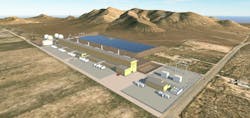Hydrostor gains $250M Goldman Sachs commitment for Long Duration, Compressed Air Energy Storage
Investment and banking giant Goldman Sachs is taking a $250 million stake in long duration energy storage that offers an alternative to the predominant lithium ion batteries.
Hydrostor Inc. announced that it is receiving the quarter billion of capital from the private equity and sustainable investing businesses within Goldman Sachs Asset Management. The financing will be used to support development and construction of Hydrostor’s 1.1 GW/8.7-GWh in advanced compressed air energy storage (A-CAES) projects in Australia and California.
“We are delighted with this investment by Goldman Sachs,” Curtis VanWalleghem, CEO and co-founder of Hydrostor, said in a statement. "It is transformational for Hydrostor and validates the competitiveness of our proprietary A-CAES solution as well as the strength of our pipeline of potential projects.”
In December, Hydrostor’s subsidiary Gem A-CAES LLC filed an application for certification of its planned 500-MW/4-GWh Gem Energy Storage Center. The A-CAES project being located near Rosamond, CA., needs certification approval by the California Energy Commission.
Hydrostor also is developing the 400-MW Pecho Energy Storage Center in San Luis Obispo County.
Gem’s ability to flexibly deliver 500 MW of stored energy for eight hours without relying on fossil fuels or other polluting resources would make it one of California’s largest single new energy storage facilities, the company said.
“As the world continues transitioning to sustainable and renewable energy sources, the need for utility-scale long-duration energy storage is clear, and Hydrostor’s A-CAES solution is well positioned to become a leading player in this emerging global market,” Charlie Gailliot, partner and head of energy transition private equity investing within Goldman Sach Asset Management, said. “We look forward to working with the Hydrostor team over the coming years and leveraging our firm’s global platform to support Hydrostor’s growth, which will play a central role in the ongoing energy transition.”
The A-CAES system uses electricity during off-peak hours to power a compressor producing heated, compressed air, which is then stored and later converted back to electricity for high demand loads.
In addition to the massive investment from Goldman Sachs, Hydrostor also has secured financing from Business Development Bank of Canada, ArcTern Ventures, Lorem Partners, Canoe Financial, Natural Resources Canada’s Energy Innovation Program and Sustainable Development Technology Canada.
About the Author
Rod Walton, EnergyTech Managing Editor
Managing Editor
For EnergyTech editorial inquiries, please contact Managing Editor Rod Walton at [email protected].
Rod Walton has spent 17 years covering the energy industry as a newspaper and trade journalist. He formerly was energy writer and business editor at the Tulsa World. Later, he spent six years covering the electricity power sector for Pennwell and Clarion Events. He joined Endeavor and EnergyTech in November 2021.
Walton earned his Bachelors degree in journalism from the University of Oklahoma. His career stops include the Moore American, Bartlesville Examiner-Enterprise, Wagoner Tribune and Tulsa World.
EnergyTech is focused on the mission critical and large-scale energy users and their sustainability and resiliency goals. These include the commercial and industrial sectors, as well as the military, universities, data centers and microgrids. The C&I sectors together account for close to 30 percent of greenhouse gas emissions in the U.S.
He was named Managing Editor for Microgrid Knowledge and EnergyTech starting July 1, 2023
Many large-scale energy users such as Fortune 500 companies, and mission-critical users such as military bases, universities, healthcare facilities, public safety and data centers, shifting their energy priorities to reach net-zero carbon goals within the coming decades. These include plans for renewable energy power purchase agreements, but also on-site resiliency projects such as microgrids, combined heat and power, rooftop solar, energy storage, digitalization and building efficiency upgrades.

